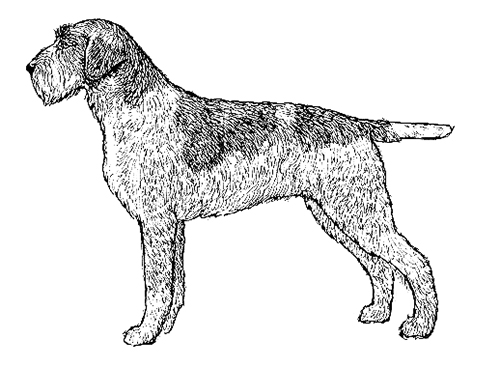Wire-Haired Pointing Griffon
Gun Dog Group
The goals and purposes of this breed standard include: to furnish guidelines for breeders who wish to maintain the quality of their breed and to improve it; to advance this breed to a state of similarity throughout the world; and to act as a guide for judges.
Breeders and judges have the responsibility to avoid any conditions or exaggerations that are detrimental to the health, welfare, essence and soundness of this breed, and must take the responsibility to see that these are not perpetuated.
Any departure from the following should be considered a fault, and the seriousness with which the fault should be regarded should be in exact proportion to its degree and its effect upon the health and welfare of the dog and on the dog’s ability to perform its traditional work.
History
This highly regarded sporting dog was perfected in Germany by a Dutchman, Edward Korthals, between 1865 and 1885. It was first known as the Korthals Griffon for this reason.
The Wirehaired Pointing Griffon was recognized by the United Kennel Club in 1936.
General Appearance
Everything about the Wirehaired Pointing Griffon indicates strength and vigor. He is a medium-sized dog, somewhat longer than tall in proportion. He has a very intelligent air. His characteristic outer coat is harsh like the bristles of a wild boar. His unkempt appearance is due to his thick, soft undercoat.
Characteristics
This breed has a biddable, affectionate nature, which makes it suitable as a family pet and guardian as well as its original purpose of a versatile hunting dog.
Head
The long head is furnished with a harsh coat, forming a mustache and eyebrows which surmount, but do not cover, the eyes.
SKULL
Long and not too wide. Stop is moderate.
MUZZLE
Long and square, the same length as the skull. Toplines of skull and muzzle lie in parallel planes.
TEETH
A full complement of strong, white teeth meet in a scissors bite.
EYES
Large and somewhat rounded. Dark yellow or brown in color, with an intelligent expression.
NOSE
The nose is always brown.
EARS
Medium size, flat, set on a line from the corner of the eye and well covered with both long and short hair.
Neck
The neck is moderately long and free of dewlap.
Forequarters
The shoulders are long and sloping.
FORELEGS
The very straight, muscular forelegs are well-furnished with thick hair. Dewclaws may be removed.
Body
Chest is rather deep, but not too wide. Ribs are moderately sprung. Back is straight and strong, and the topline slopes very gently from withers to tail. Loin and croup are strong and not too short.
Hindquarters
Well muscled with angulation that balances with the forequarter.
HIND LEGS
Thighs long and well muscled, good angulation at the hock joint. Legs are well furnished with thick hair.
Feet
Round and tight, with well arched toes.
Tail
The tail is generally docked by a third. It is carried horizontally or with the tip slightly raised, and is furnished with a hard coat, but is without plume.
Coat
Double. The outer coat is hard, dry and stiff. The undercoat is thick and downy.
Color
Steel gray with liver patches, solid liver, liver roan, liver and white, orange and white.
Height
Height range for males is 21½ to 23½ inches. Height range for females is 19½ to 21½ inches.
Eliminating Fault
(An Eliminating Fault is a Fault serious enough that it eliminates the dog from obtaining any awards in a conformation event.)
Curly or wooly outer coat.
Disqualifications
(A dog with a Disqualification must not be considered for placement in a conformation event, and must be reported to UKC.)
Unilateral or bilateral cryptorchid.
Viciousness or extreme shyness.
Black coat or nose color.
Albinism.
The docking of tails and cropping of ears in America is legal and remains a personal choice. However, as an international registry, the United Kennel Club is aware that the practices of cropping and docking have been forbidden in some countries. In light of these developments, the United Kennel Club feels that no dog in any UKC event, including conformation, shall be penalized for a full tail or natural ears.

Looking for a Dog?
Find a dog that will fit your family.
Note: The breeders on this list are not endorsed by UKC.
Revised January 1, 2007
©Copyright 1992, United Kennel Club
